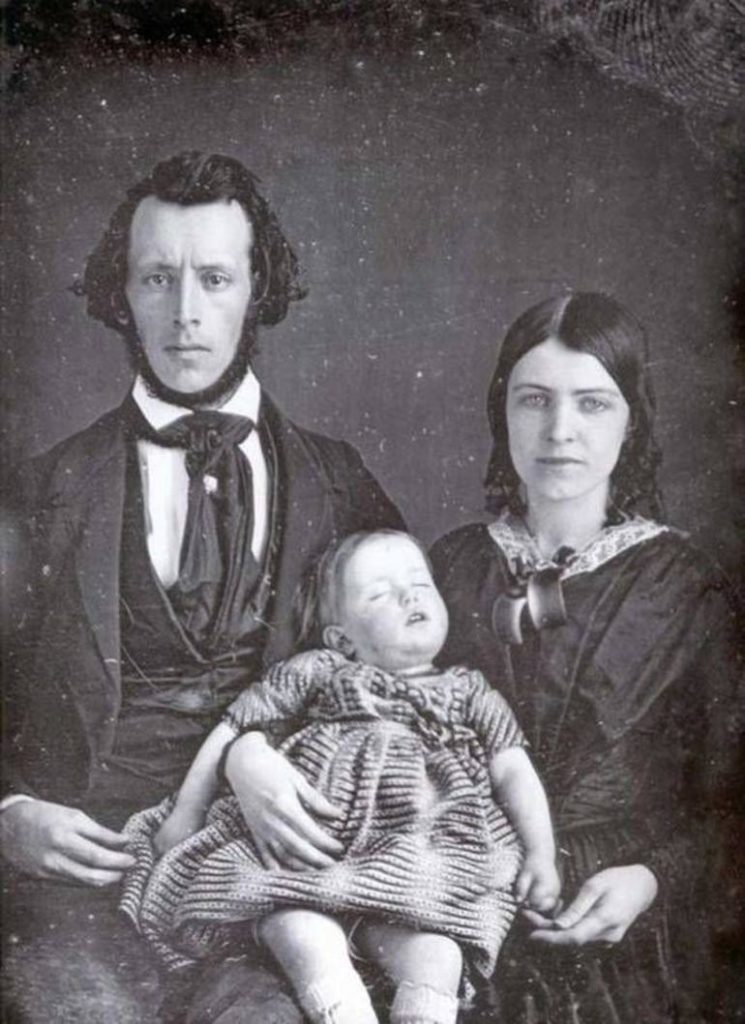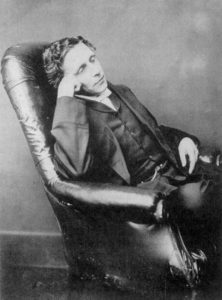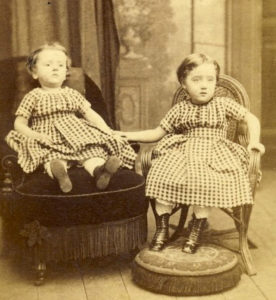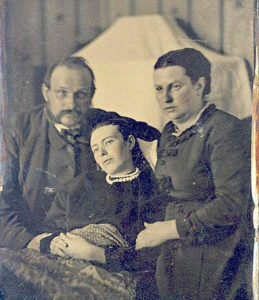
Fotoğrafçılığın henüz yaygınlaşmaya başladığı ve oldukça lüks sayıldığı 19. yüzyılın sonlarında,özellikle Avrupa ülkelerinde görülen,ölülerin defin öncesi hatıra amaçlı fotoğraflanma işlemidir. Kimi zaman salgın hastalıklar, kimi zaman savaşlar nedeniyle genç yaşta ölümlerin arttığı bu dönemde ölülerin hazırlanarak fotoğrafının çekilmesi gayet normal karşılanmaktaydı. Nadir de olsa çok sevilen evcil hayvanların da bu şekilde örnekleri mevcuttur.
Post-mortem photography (also known as memorial portraiture or a mourning portrait) is the practice of photographing the recently deceased. These photographs of deceased loved ones were a normal part of American and European culture in the nineteenth and early twentieth centuries. Commissioned by grieving families, postmortem photographs not only helped in grieving, but often represented the only visual remembrance of the deceased and were among a family’s most precious possessions.[1] There can be considerable dispute as to whether individual early photographs actually show a dead person or not, often sharpened by commercial considerations.
The form continued the tradition of earlier painted mourning portraits. Today post-mortem photography is most common in the contexts of police and pathology work.
Peki, ölüler neden fotoğraflanır? Ölü, yaşayanlar için “öteki”dir aslında, bu yüzden akla “korkutucu” bir şey olarak gelir. Özellikle 19.yüzyılda fotoğrafın ilk çıktığı zamanlara geri dönecek olursak, orta sınıf için ölülerinin belgelenmesi de yaşayanların belgelenmesi kadar popüler bir olaydı kuşkusuz.
Post-mortem photography was very common in the nineteenth century when “death occurred in the home and was quite an ordinary part of life.” As photography was a new medium, it is plausible that “many daguerreotype post-mortem portraits, especially those of infants and young children, were probably the only photographs ever made of the sitters. The long exposure time made deceased subjects easy to photograph.’ (The problem of long exposure times also led to the phenomenon of hidden mother photography, where the mother was hidden in-frame to calm a young child and keep them still.) According to Mary Warner Marien, “post-mortem photography flourished in photography’s early decades, among clients who preferred to capture an image of a deceased loved one rather than have no photograph at all.”
Yaşayanlar fotoğraflanabiliyorsa, haliyle ölüler de fotoğraflanabilirdi. Üstelik, ölülerin hareketsiz duruşu, uzun pozlama süresini hesaba katacak olursak o yıllarda bir fotoğrafçı için mükemmel pozu sağlıyordu.Bu pozları sağlamak için ayakta duracak şekilde bazı aparatlar ve bazen yastık benzeri şeylerde kullanılabiliyordu.
These photographs served as keepsakes to remember the deceased. The later invention of the carte de visite, which allowed multiple prints to be made from a single negative, meant that copies of the image could be mailed to relatives. Approaching the 20th century, cameras became more accessible and more people began to be able to take photographs for themselves.
The practice eventually peaked in popularity around the end of the 19th century and died out as “snapshot” photography became more commonplace, although a few examples of formal memorial portraits were still being produced well into the 20th century.
Viktoryen çağda, özellikle ölü bebek ve çocuk fotoğraflarının göze çarpması oldukça ilginç bir noktadır.Bebekler genelde küçük bir tabut içinde gösterilirken, bazen de aile bireyleri ile birlikte bir anı fotoğrafına dönüştürülmüştür. 18.YY’da Ölülerin Fotoğraflanması adlı kitabında, post-mortem fotoğrafçılığın Avrupa’da başlayıp daha sonra Amerika’ya doğru yayıldığını belirtmiştir ,orta sınıf ailelere ait olan bu gelenek, Amerika’da 1920’lere gelindiğinde yok olmuştur.
The earliest post-mortem photographs are usually close-ups of the face or shots of the full body and rarely include the coffin.The subject is usually depicted so as to seem in a deep sleep, or else arranged to appear more lifelike. Many of these subjects were also clothed in their best apparel. After all, these photographs would serve as their last social presence. Children were often shown in repose on a couch or in a crib, sometimes posed with a favorite toy or other plaything. It was not uncommon to photograph very young children with a family member, most frequently the mother. Flowers were also a common prop in post-mortem photography of all types.
Post-mortem fotoğraflarda önemli nokta, ölen kişiye bakacak olan kişilerin ölüyü anımsaması, unutmaması, fotoğrafın ölen şahsın kişisel özelliklerini, yani karakteristiğini yansıtmasıdır. Bunun iki farklı yüzü olabilir. Birincisi, ölü herhangi bir mimik yapamayacağından kişiye ait net ifade fotoğrafa yansıyacaktır; ikincisi ise bu yalnızca ölüye ait bir ifade, “mimiksiz bir mimik” olacaktır. Yaşayan herhangi bir insan, bir ölü kadar ifadesiz duramaz. Bir ölü de yaşayan bir insan gibi duramaz. Eninde sonunda bu fotoğraf, geride kalanların hatırlamasına yarayacak bir obje olacaktır.
While some images (especially tintypes and ambrotypes) have a rosy tint added to the cheeks of the corpse, it is untrue that metal stands and other devices were used to pose the dead as though they were living. The use by photographers of a stand or arm rest (sometimes referred to as a Brady stand), which aided living persons to remain still long enough for the camera’s lengthy exposure time, has given rise to this myth. While 19th-century people may have wished their loved ones to look their best in a memorial photograph, evidence of a metal stand should be understood as proof that the subject was a living person.
Post-mortem fotoğraflarda dikkat çeken bir diğer özellik ise, ölen kişiyi tıpkı natürmort (ölüdoğa) tablolarındaki gibi gösterme biçimi. Bir fotoğrafta, sandalyeye oturtulmuş bir adam, yanında bir masa ve masanın üzerinde bir kitapla gösterilmiştir. Bu marifet, büyük bir olasılıkla fotoğrafçıya ait olmalıdır. Natürmort tablolarda da gördüğümüz buna benzer bir tür düzenleme yapıldığıdır.
Later photographic examples show the subject in a coffin. Some very late examples show the deceased in a coffin with a large group of funeral attendees; this type of photograph was especially popular in Europe and less common in the United States.
Burada asıl önemli olan, ölüyü belgelemekse, fotoğrafçı fazladan böyle bir masa ve kitabı koyma ihtiyacını neden duymuştur? Masayı koymadan da, adamı sandalyeye yerleştirebilirdi. Bu fotoğrafın bir ölü fotoğrafı olduğunu bilmesek, adamın sadece bir poz verdiğini, masanın ve kitabın da bir dekor olduğunu düşünebilirdik. Kitabını biraz önce okumuş ve fotoğrafçıya poz vermiş sıradan bir adam olacaktı. Eylem içerisinde olan, yani “hayat belirtisi” gösteren bir adam. Dolayısıyla, geride kalanlar bu fotoğrafa baktıklarında adamın ölmüş olduğunu düşünmek istemeyeceklerdi belki de.
Post-mortem photography is still practised and is common in America among women who experienced stillbirth, where the mother or parents are photographed holding the stillborn child, and commemorated on websites such as “Now I Lay Me Down To Sleep”. This style of mother holding child was also common in the Victorian era when death of infants was common. Photographs, especially depicting persons who were considered to be very holy lying in their coffins, are still circulated among faithful Eastern Catholic, Eastern Orthodox and Oriental Orthodox Christians.
A variation of the memorial portrait involves photographing the family with a shrine (usually including a living portrait) dedicated to the deceased.
Özetle, ölüyü belgelemenin tarihi fotoğrafla başlamamıştır. Daha önce ressamlar tarafından tuvale aktarılmış, fotoğrafın icadıyla birlikte bir dönem Avrupa ve Amerika’da oldukça popüler olmuştur.




